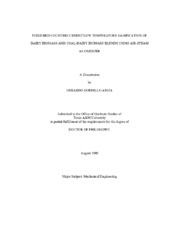| dc.description.abstract | Concentrated animal feeding operations such as cattle feedlots and dairies
produce a large amount of manure, cattle biomass (CB), which may lead to land, water,
and air pollution if waste handling systems and storage and treatment structures are not
properly managed. However, the concentrated production of low quality CB at these
feeding operations serves as a good feedstock for in situ gasification for syngas (CO and
H2) production and subsequent use in power generation. A small scale (10 kW)
countercurrent fixed bed gasifier was rebuilt to perform gasification studies under quasisteady
state conditions using dairy biomass (DB) as feedstock and various air-steam
mixtures as oxidizing sources. A DB-ash (from DB) blend and a DB-Wyoming coal
blend were also studied for comparison purposes. In addition, chlorinated char was also
produced via pure pyrolysis of DB using N2 and N2-steam gas mixtures.
The chlorinated char is useful for enhanced capture of Hg in ESP of coal fired
boilers. Two main parameters were investigated in the gasification studies with air-steam
mixtures. One was the equivalence ratio ER (the ratio of stochiometric air to actual air) and the second was the steam to fuel ratio (S:F). Prior to the experimental studies, atom
conservation with i) limited product species and ii) equilibrium modeling studies with a
large number of product species were performed on the gasification of DB to determine
suitable range of operating conditions (ER and S:F ratio). Results on bed temperature
profile, gas composition (CO, CO2, H2, CH4, C2H6, and N2), gross heating value (HHV),
and energy conversion efficiency (ECE) are presented.
Both modeling and experimental results show that gasification under increased
ER and S:F ratios tend to produce rich mixtures in H2 and CO2 but poor in CO.
Increased ER produces gases with higher HHV but decreases the ECE due to higher tar
and char production. Gasification of DB under the operating conditions 1.59<ER less than6.36
and 0.35<s:f>less than0.8 yielded gas mixtures with compositions as given below: CO (4.77 -
11.73 %), H2 (13.48 - 25.45%), CO2 (11-25.2%), CH4 (0.43-1.73 %), and C2H6 (0.2-
0.69%). In general, the bed temperature profiles had peaks that ranged between 519 and
1032 degrees C for DB gasification. | en |


